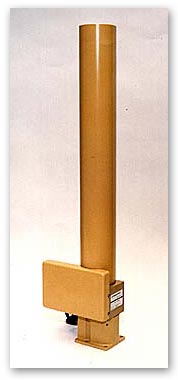TRIGA Control Rod Drive
 The TRIGA® Control Rod Drive for research reactors is an electrically driven linear drive mechanism to position and control movement of the reactor control rods and control blades.
The TRIGA® Control Rod Drive for research reactors is an electrically driven linear drive mechanism to position and control movement of the reactor control rods and control blades.
 The Control Rod Drive Mechanism is an electric-stepping, motor-actuated linear drive equipped with a magnetic coupler and a positive feedback potentiometer. A five-phase stepping motor drives a pinion gear and a 10-turn potentiometer via a chain and pulley gear mechanism. The pinion gear engages a rack attached to the draw tube, housing an electromagnet attached to the lower end. The electromagnet in turn engages an iron armature, which is attached to a connecting rod assembly, which terminates at its lower end in the control rod itself. The electromagnet, armature and the upper portion of the connecting rod are all housed in a tubular barrel that extends below the water line in the reactor pool. The upper portion of this barrel is ventilated to permit unrestricted rod movement in water, whereas the lower portion has graded vent holes to restrict movement and to provide a damping action when the electromagnet is deenergized and the control rod is released from the drive.
The Control Rod Drive Mechanism is an electric-stepping, motor-actuated linear drive equipped with a magnetic coupler and a positive feedback potentiometer. A five-phase stepping motor drives a pinion gear and a 10-turn potentiometer via a chain and pulley gear mechanism. The pinion gear engages a rack attached to the draw tube, housing an electromagnet attached to the lower end. The electromagnet in turn engages an iron armature, which is attached to a connecting rod assembly, which terminates at its lower end in the control rod itself. The electromagnet, armature and the upper portion of the connecting rod are all housed in a tubular barrel that extends below the water line in the reactor pool. The upper portion of this barrel is ventilated to permit unrestricted rod movement in water, whereas the lower portion has graded vent holes to restrict movement and to provide a damping action when the electromagnet is deenergized and the control rod is released from the drive.
A series of microswitches on the drive assembly controls the up-down movement of the control rod and rod drive. Rod up/down motion is controlled from the control console. In the event of a reactor scram, the magnet is deenergized and the armature will be released. The control rod will then drop, reinserting the neutron poison into the reactor core.
The control rod drive speed is adjustable over a wide range, and its design can accommodate control rods in lengths of 15, 24, 30 or 36 inches.